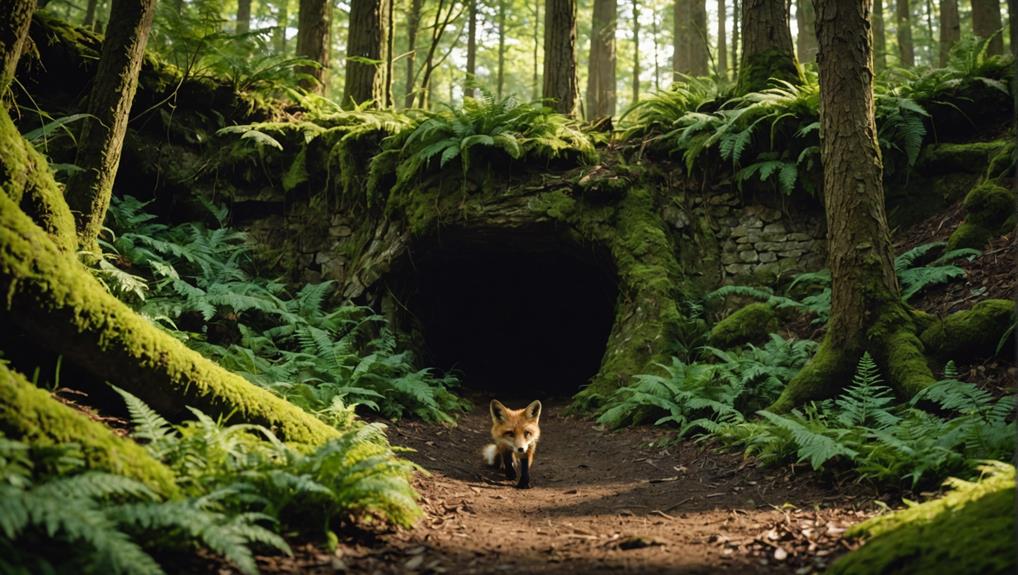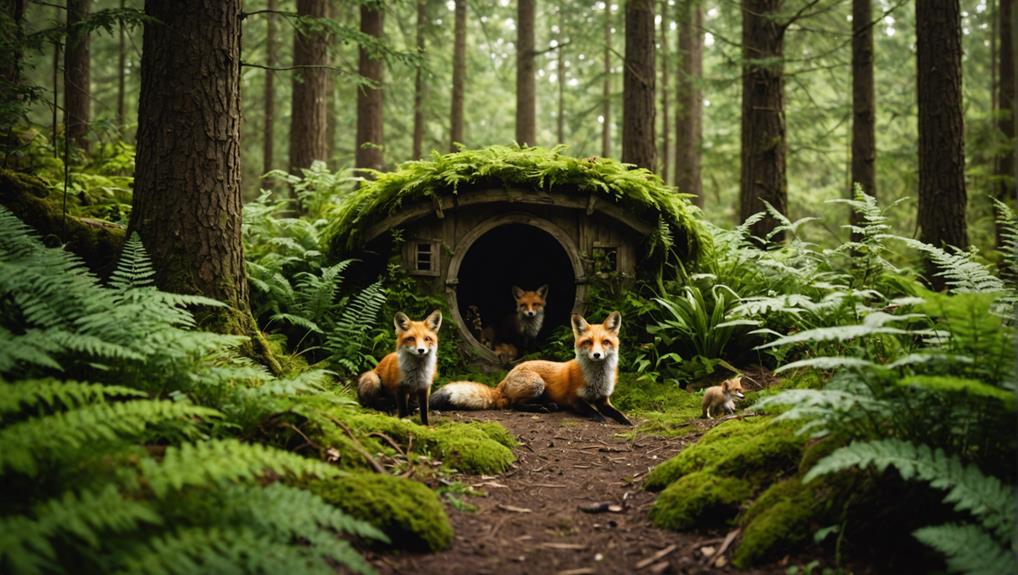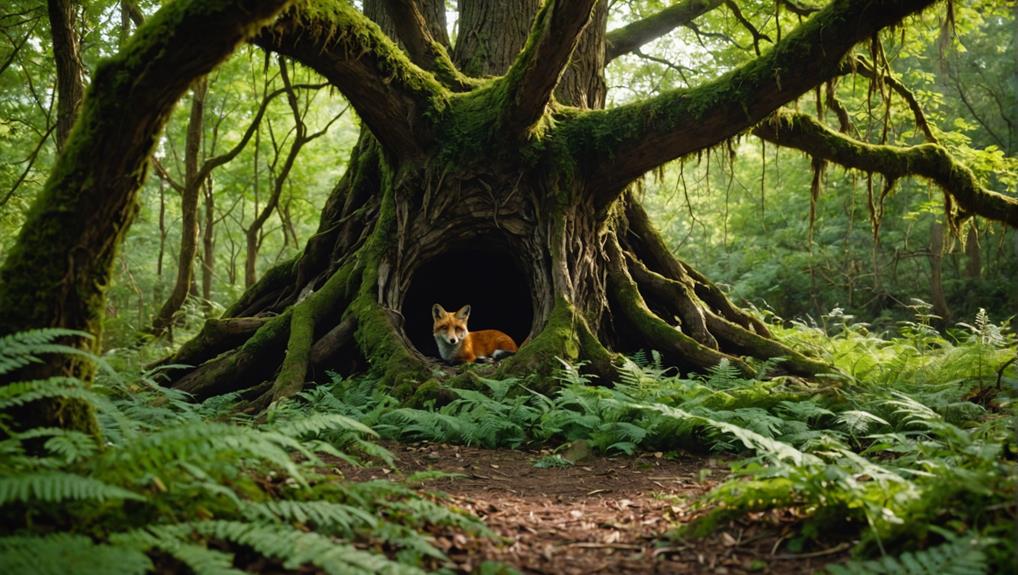Exploring fox dens is like uncovering a secret world where these cunning critters make their home! You'll find their dens, or "earths," tucked away in loose, well-drained soil, often surrounded by dense vegetation for safety. Foxes are surprisingly adaptable, setting up shop in both rural and urban areas. With multiple entrances—some dens even have up to 19!—they're all about quick escapes. These homes not only keep them warm but also help enhance the soil and plant diversity around them. Curious about how this all affects our ecosystems? There's a lot more to discover on this wild journey!
Contents
Overview of Fox Dens
Fox dens, often called "earths," serve as essential shelters for these clever creatures. You might be surprised to learn that a typical den consists of entrance tunnels leading to cozy chambers, perfect for resting and raising cubs. These tunnels can stretch up to 5-7 meters long—quite the maze, right?
Foxes are picky about their habitat preferences, favoring loose, well-drained soils with dense vegetation for extra shelter. Their intricate dens not only provide warmth but also protection from predators, highlighting their adaptability in harsh environments key adaptations for survival.
What's really interesting is that foxes don't just stick to one den. They often use multiple dens within their territory for various needs, like nursing little ones or simply catching some z's. Their natal dens, where the cubs are born, are usually larger and sport more openings compared to resting sites.
Plus, they've got a knack for choosing den sites on southeast-facing slopes, with a whopping 95% of dens in eastern Germany found in this orientation. It seems that shrub cover is their best friend, while dense forests? Not so much.
Geographic Distribution of Foxes
When you think about where foxes make their homes, you might picture them in the countryside, but guess what?
These clever critters thrive in both rural and urban areas, adapting to all sorts of environments.
Urban foxes exhibit remarkable boldness with humans, often venturing close to people and scavenging for food.
Whether they're sneaking through a city park or roaming the old fields, their knack for finding cozy dens keeps them one step ahead of the game!
Habitat Preferences Overview
Covering a diverse range of habitats, red foxes adapt well to various environments, showcasing their remarkable versatility. These clever creatures thrive almost everywhere, from rural fields to bustling urban areas.
When you think about habitat preferences, keep in mind that red foxes love open spaces with some greenery, avoiding those vast, empty fields or dense forests. They need shelter and food availability, so they seek out mixed landscapes, like old fields, forests, and farmland, where they can hunt and hide. Their adaptability to different environments, including urban settings, highlights their success in urbanization and adaptability.
In suburban neighborhoods, red foxes have a knack for blending in with human life. You might spot them using gardens and even backyards as denning sites.
They're pretty resourceful, finding cozy spots in broken wood lines, lawns, and roadside ditches. This flexibility in choosing denning sites shows how well they adapt to local conditions.
Urban Vs. Rural Distribution
The distribution of red foxes varies substantially between urban and rural areas, reflecting their adaptability to different environments. Urban foxes have become quite the city slickers, often choosing den locations that would surprise you—like gardens, sheds, and even occupied buildings!
In contrast, rural foxes prefer the great outdoors, settling into abandoned burrows nestled in wooded areas.
Since the 1930s, the urban fox population has exploded, with about 430,000 living in the UK as of 2017. They occupy smaller territory sizes—averaging around 90 hectares—because they can rely on nearby human structures for food and shelter.
Rural foxes roam much larger territories, ranging from 100 to 1,000 hectares, as they hunt in a more competitive environment with less predictable resource availability.
However, urban life isn't all sunshine and rainbows. Studies show that urban fox populations can fluctuate dramatically, like the 42% decline in 2018, mostly due to shifting food sources and competition.
Characteristics of Fox Burrows

When you think about fox burrows, or dens, imagine cozy little underground hideouts that vary quite a bit.
Some dens even have multiple entrances, like a fox's own secret maze, making sure they've plenty of escape routes if needed.
You'll find these homes tucked away in spots with loose soil and thick vegetation, perfect for a fox to raise its little cubs while staying safe from prying eyes.
Den Structure Variability
Exhibiting remarkable adaptability, fox dens showcase a variety of structures that cater to their specific needs. You might be surprised to learn that these clever creatures can create or take over dens in many ways.
Here are three interesting facts about their den structure:
- Entrance Tunnels: Fox dens typically have entrance tunnels that can stretch from 5 to 17 meters long, leading to cozy sleeping chambers.
- Diverse Entrances: A single den can feature up to 19 entrances, especially in natal dens where cubs are raised, while resting dens sport smaller, more discreet entrances.
- Soil Preferences: Foxes prefer well-drained soils for their dens, nestled within dense vegetation, showing their knack for finding the perfect habitat.
These structures help foxes adapt to the environment, reflecting their resourcefulness. They often take over abandoned burrows from rabbits and badgers, but they're also skilled at digging their own dens when needed.
The unique design of fox dens not only provides shelter but also offers a safe space for resting and raising their young. So, next time you hear a rustle in the bushes, remember there might just be a clever fox den nearby!
Preferred Habitat Features
Fox burrows, often referred to as dens, thrive in specific habitat features that cater to the needs of these adaptable animals. You'll find their denning sites typically nestled in loose, well-drained soil, surrounded by dense vegetation. This not only provides them shelter but also helps them stay hidden from predators—talk about a clever hiding spot!
Urban foxes are a bit less picky when it comes to their homes. They often make cozy dens in gardens, under sheds, or even in commercial areas, while their rural cousins prefer more natural environments.
The presence of fox earths can actually boost soil fertility and enhance plant diversity in the surrounding areas, thanks to the organic waste and seed dispersal from our furry friends.
Interestingly, foxes often choose denning sites at moderate elevations, favoring places with plenty of shrub cover and steering clear of dense forests.
With multiple entrances—sometimes as many as 19—it's easy to see why these clever critters can dart in and out with such agility. So, next time you spot a fox, remember they've got a whole world of habitat preferences backing their adventurous spirit!
Environmental Influences on Den Sites
The location of a fox den often reveals the intricate relationship between the environment and the species' denning behavior. When you think about where foxes choose to set up their homes, consider these key factors:
- Soil Type: Loose, well-drained soil is a favorite.
- Vegetation: Dense shrubs offer essential cover.
- Elevation: Moderate heights seem to attract them.
Foxes are pretty selective about where they dig in. They tend to favor southeast-facing slopes, especially in eastern Germany, where 95% of dens were found on slopes averaging a 20-30 degree gradient. This shows they've a knack for picking just the right spot!
However, they don't like being near roads. In fact, den occurrence drops considerably with closer proximity to roads, which means human activity can really shake up their habitat selection.
When it comes to vegetation, a high shrub cover correlates positively with den sites, while dense forests don't attract them as much.
Role of Foxes in Ecosystems

In many ecosystems, foxes play an essential role in maintaining balance by regulating prey populations, particularly small mammals. These clever creatures help keep numbers in check, preventing any one species from overwhelming the environment. When you think about it, they're like nature's little pest controllers!
But that's not all. Foxes also contribute to nutrient cycling by scavenging on carrion, which helps clean up the landscape and limits disease spread.
Their presence can even boost plant life! As they roam around, they facilitate seed dispersal through their fur and scat, promoting biodiversity. Who knew foxes could be gardeners, too?
In urban ecosystems, foxes adapt surprisingly well. Their ability to thrive alongside humans means they can still impact local wildlife dynamics.
You might just spot one sneaking through your neighborhood, reminding you that nature can coexist with city life.
Conservation Challenges for Fox Habitats
Conservation challenges for fox habitats pose significant threats to these essential ecosystems. As you explore the world of foxes, it's important to recognize these three major issues:
- Habitat loss due to urban development and agricultural expansion.
- Human-wildlife conflict that disrupts the delicate balance of nature.
- The need for effective conservation strategies to protect den locations.
In regions like the Shigar Valley, fox populations are facing a tough time. Urban sprawl and road construction are pushing them out of their homes, leading to habitat loss.
Even though red foxes are adaptable, they're struggling to avoid human activity. This means we need to come up with smart conservation strategies that not only protect their habitats but also reduce conflicts with humans.
Understanding den locations is key, too. Factors like distance to roads and the type of vegetation can influence where foxes choose to live.
Remember, foxes play critical ecological roles, such as seed dispersal and keeping prey populations in check. By addressing these challenges, we can guarantee that these clever creatures thrive in their natural homes.
Let's work together to make a positive impact!
Final Thoughts
So, next time you spot a fox, remember there's a whole world beneath its paws, filled with cozy dens and untold stories. These clever critters play an essential role in our ecosystems, but they need our help to thrive. By protecting their habitats, we're not just saving foxes; we're preserving a bit of wild magic in our own backyards. Let's work together to keep their homes safe, because every fox deserves a den that feels like home sweet home!














